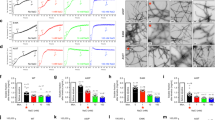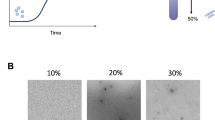Abstract
replying to J. Burré et al. Nature 498, 10.1038/nature12125 (2013)
In disagreeing with our report that native α-synuclein occurs physiologically as an α-helically folded tetramer in neural and erythroid cells1, Burré et al.2 conclude instead that ‘native brain α-synuclein’ consists of a largely unstructured monomer. They make two implications about our paper that are inaccurate: (1) that our findings pertained only to erythrocyte α-synuclein (we reported multiple experiments on neural cells); and (2) that we concluded that cellular α-synuclein is a stable tetramer under all conditions (we did not use the term ‘stable’, and we observed monomers and some other oligomers in normal cells (e.g., Fig. 1d of ref. 1)). Indeed, we emphasized the need to discover “compounds that … could kinetically stabilize native tetramers and prevent pathogenic α-synuclein aggregation”. Although the data in our report suggest that tetramers are the predominant native species, tetramers and other oligomers arise from monomers, so there must be an equilibrium between monomeric and oligomeric forms in cells. Pathogenic events (e.g., mutations) could alter this equilibrium, and some therapeutic compounds could potentially re-establish it, as we explicitly suggested1.
This is a preview of subscription content, access via your institution
Access options
Subscribe to this journal
Receive 51 print issues and online access
$199.00 per year
only $3.90 per issue
Buy this article
- Purchase on Springer Link
- Instant access to full article PDF
Prices may be subject to local taxes which are calculated during checkout
Similar content being viewed by others
References
Bartels, T., Choi, J. G. & Selkoe, D. J. α-Synuclein occurs physiologically as a helically folded tetramer that resists aggregation. Nature. 477, 107–110 (2011)
Burré, J. et al. α-Synuclein in brain cytosol is monomeric. Nature 498, http://dx.doi.org/10.1038/nature12125 (2013)
Davidson, W. S., Jonas, A., Clayton, C. F. & George, J. M. Stabilization of α-Synuclein secondary structure upon binding to synthetic membranes. J. Biol. Chem. 273, 9443–9449 (1998)
Wang, W. et al. A soluble α-synuclein construct forms a dynamic tetramer. Proc. Natl Acad. Sci. USA. 108, 17797–17802 (2011)
Westphal, C. H. & Chandra, S. S. Monomeric synucleins generate membrane curvature. J. Biol. Chem. 288, 1829–1840 (2013)
Dettmer, U., Newman, A. J., Luth, E. S., Bartels, T. & Selkoe, D. In vivo crosslinking reveals principally oligomeric forms of α-synuclein and β-synuclein in neurons and non-neural cells. J. Biol. Chem. 288, 6371–6385 (2013)
Author information
Authors and Affiliations
Corresponding author
Rights and permissions
About this article
Cite this article
Bartels, T., Selkoe, D. Bartels & Selkoe reply. Nature 498, E6–E7 (2013). https://doi.org/10.1038/nature12126
Published:
Issue Date:
DOI: https://doi.org/10.1038/nature12126
This article is cited by
-
Amyloid β-protein oligomers and Alzheimer’s disease
Alzheimer's Research & Therapy (2013)
Comments
By submitting a comment you agree to abide by our Terms and Community Guidelines. If you find something abusive or that does not comply with our terms or guidelines please flag it as inappropriate.



